|
A Victorian Lifestyle in the Modern World
By Sarah A. Chrisman
Posted September 2016

"From my earliest boyhood, ancient wearing apparel, old household and kitchen utensils, and antique furniture, have appealed to me with peculiar force, telling facts and relating incidents to me in such a plain, homely but graphic manner of the every-day life of our ancestors, that I look upon them more as text-books than as curiosities; for it is only by the light of truth reflected from these objects that we are enabled to…pierce the…fiction with which the perspective of years surrounds the commonest objects of those remote times."
-
Dan C. Beard, "Six Feet of Romance," The Cosmopolitan. July, 1889. p. 226.
My husband Gabriel and I research late-Victorian history, specifically the 1880s and '90s. We do so
by constantly interacting with as many aspects of it as possible. When people visit our home, they say it's like walking into a museum—or stepping back in time. Our whole life together is an experiential study into the period we love.
|
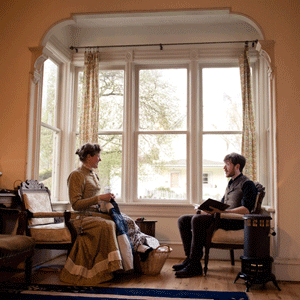
|
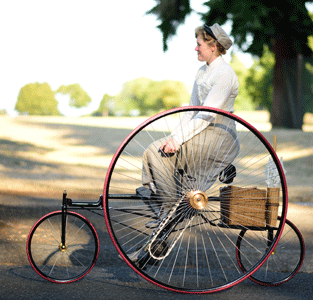
|
|
Gabriel reading to me from an antique book while I sew.
|
My 1880s-style ladies' high wheel tricycle.
|
Like any other historians, we read extensively in primary sources, books and other texts written during the period. Unlike most historians, we take things significantly farther and build our daily lives around the culture. We constantly use the technologies
of the time, from a wood-burning stove to high wheel cycles. We embrace its values as well, from the philosophy that one should never leave home with unkind words to the idea that part of the husband's duty is to give his wife every advantage it is possible to bestow1.
The Victorians believed that husbands and wives should "Consult and advise together in all that comes within the experience and sphere of individuality."2 Gabriel and I do exactly that. He has a degree in history and a Master's in Library Science; my own university degrees are in the field of Cultural Studies. We've combined Gabriel's love of primary-source research with immersion techniques from my Cultural Studies background, and by doing so, we've created a life which is uniquely beautiful—and uniquely ours.
Years ago, we started collecting everyday items from the past, things people like us were interacting with on a daily basis back in the Victorian era. We've never been privileged to keep company with monarchs and presidents in the modern world, so where history is concerned we've always been drawn far more strongly to people we can relate to ourselves. We love simple stories of approachable people. Using the things they used and adopting their routines help us connect with their culture. It's not so very different from when I went to other countries to learn more about their cultures, although it's been a more gradual and challenging process than stepping on a plane.
|
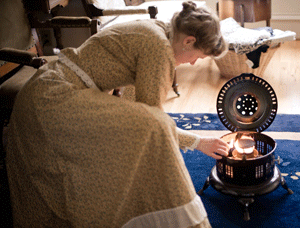
|
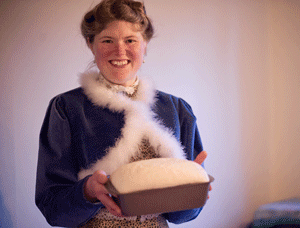
|
|
Lighting our kerosene heater.
|
Baking bread.
|
Clothes from the past led us on the first steps of this journey. From collecting antique 19th
century garments, we moved on to carefully trying them on and wearing them for special occasions. Clothes are incredibly intimate. They influence how we move, and at the same time record tiny details about us that seem too mundane to write down—things like whether the things in our pockets are light or heavy, or what we do with our hands when we don't have pockets at all. When Gabriel and I realized how much the old garments were teaching us, we moved on to copying painstakingly accurate versions of them to wear everyday.
Now all our clothes are Victorian, copied from antiques in our collection or based on 19th
century photographs and fashion plates. I sew all my own clothes by hand, and Gabriel's are made for him by a seamstress in Seattle.
Important as they were (and continue to be), our clothes were just the first step in our studies of the Victorian era. The next step was moving to a Victorian town: Port Townsend, Washington State. The city's formative years were the very decades which fascinate us so much. Late 19th century architecture remains the dominant feature here, and Port Townsend is proud to be known as a Victorian seaport.
Construction on our house began in 1888 and finished in 1889. In the 20thcentury, this middle-class, Eastlake-style building endured a long period of benign neglect. We bought it six years ago, and ever since we moved in, we've been slowly restoring it to the glorious functionality it boasted when it was new.
Nearly everything in our house now is Victorian in nature. Many are original antiques. Some (such as the wicks which go into our antique oil lamps) are made by artisans who create extremely accurate replicas of items from the period. Others (like the Ivory soap I use to hand-wash our clothes and our dishes) are new examples of products which have been manufactured by the same companies since the 1800s.
The artifacts which make up our home are a working collection. When we get our antiques, most are at a severe level of deterioration. Some people wouldn't think twice about smashing such low-quality items to bits for decorating Steampunk jewelry or ripping them to shreds for scrap material. We fix them up and put them back to the use for which they were originally intended.
As we use and interact with them, they become our teachers.
One of the first Victorian appliances we procured was an antique icebox. We sold our electric refrigerator long ago, and we've never regretted it. Ever since, we've been using our icebox to keep our perishables fresh. We stock it with sixty pounds of block ice once or twice a week, and we've gotten so practiced at loading it together that the process almost feels like dancing. The slow drip of melting ice is one of the constant, quiet sounds of our home, and every morning, I empty the meltwater from the drip
tray.
In the opposite corner of the kitchen from our icebox sits its complement: our wood-burning Charm Crawford stove, a beautifully restored antique from 1901.3 It took us years to save up for it, and the day it arrived was an occasion of enormous pride. Tending the stove —cleaning its firebox, sifting the ashes, laying new fires, and keeping the fire going— has become another element of my daily routine. Caring for the stove is incredibly grounding and a constant, tangible connection to history. It constantly has new things to teach me, and I delight in every moment of it.
When we're the only ones at home, we use oil lamps. I fill these lamps, clean their chimneys and care for their wicks several times a week in the dark months a year; in the brighter seasons, they last longer. It's a wonderful way to connect with the changing seasons; by linking us to the light rhythms of the natural world, it makes us feel more alive ourselves. It heightens our awareness of the resources we're using as well: when a lamp has to be filled and cared for, one naturally is more mindful of when it's really needed. At the same time, the lamps connect us to the technologies of our forebears: we've learned how much brighter circular wick lamps are than those with flat wicks, and we've been fascinated to see how much brighter antique lamps (which were made for use) are than modern replicas (often intended for mere ambiance).
The electric lights in our house (mostly used for company) are all replicas of early light bulb patents, made from hand-blown glass. A few are Edison designs because people inevitably expect to see the Great Names of History represented. Really though, we prefer the hidden stories of the past: most of the light bulbs in our home are Westinghouse designs, based on the brilliant work of Nikola Tesla.
Every detail of our home is as authentically Victorian as we can possibly make it. Our bed is an antique (a lucky yard-sale find), and I hand-sewed its feather mattress. Every morning, I wash using an antique ewer and basin. Not only does this conserve water dramatically, but it's also much kinder to my skin than daily showers. When I wash my hair I use Castille soap, just as suggested in an 1889 edition of Good Housekeeping.4
I'm an author; as with any true writer, it's not just my profession but how I experience the world. I keep a diary every day, using an antique mother-of-pearl fountain pen I bought with part of my first book advance. I draft a lot of my manuscripts the same way: I enjoy this tangible connection to my words. (There have been some really interesting studies done showing the human brain processes information more thoroughly when it's written by hand as opposed to typed.5) When I take notes from antique books and magazines, I use a pencil to avoid dribbling ink on irreplaceable antique volumes.
I had to search for a while before I found a source for liquid ink which flows smoothly from the pen without clumping. I finally determined the best ink for my purposes comes from a company which has been in business since 1670.6 They also produce my favorite blotting paper. I made my blotting pad myself, and my rocker blotter is another antique.
Since no publisher on Earth will accept a handwritten manuscript anymore, I still have to type out my work before I submit it. I used to throw away my rough drafts after I had transcribed them: they had served their function, and there seemed little purpose in them continuing to take up space. However, after the publication of my most recent book, people started expressing interest in my handwritten pages so I started saving them.
I've written several narrative non-fiction books about the Victorian era and our relationship with it. Currently, I'm working on a cookbook comprised of 19th
century recipes. I test each one, then add instructions regarding quantities and notes to make them easier to follow. I'm also working on a series of novellas set in the 1880s and '90s. All our first-hand experiences with the technologies and everyday items of the time provide incredibly valuable insights on which to build these works.
Gabriel works at a bicycle shop. The B.I. Cycle Shop is a modern store, with brands familiar to 21st century cyclists. However, its products do have this in common with early cycling: the mechanical technology is very advanced, yet it's still technology which people can see and understand. Better yet, it's technology which originated in our favorite period!
|
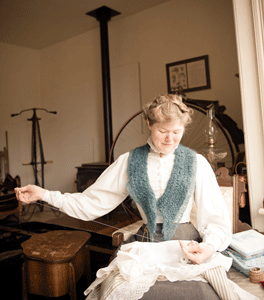
|
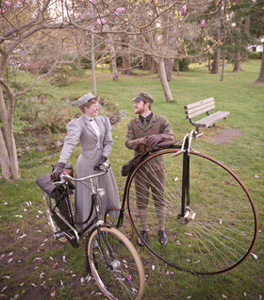
|
|
Sewing in our parlor. I sew all my clothes by hand.
|
My safety bike, and one of Gabriel's Ordinary bicycles.
|
I've never had a driver's license, and my bicycle is from a company that has been making bikes with the same basic frame geometry since the 1890s. My bicycle serves the same function for me as most people's "daily driver" car serves for them. It weighs 50 pounds, which would have been extremely heavy even by 1890s standards. Yet, I've covered hundreds of miles on it. It helps me do my errands (whether I'm riding a mere four or five miles around town, or 25twenty-five miles out and back to a farm
stand), but I've ridden much farther on it as well. Longer rides ranged anywhere from 50 miles out and back to visit another Victorian town7, to 100 miles to see the flowers in bloom in America's top tulip-producing county8, to an international ride up to Canada last year with Gabriel, who rode one of his high wheel bicycles. I have my own high wheel, an 1880s-style ladies' tricycle which at around 75 pounds is even heavier than my bike. In the 1880s, there were women who managed to ride high wheel tricycles over the Alps, but the farthest I've managed on mine was a 75-five mile trip across the Idaho panhandle last year9. (Gabriel was on one of his high wheel bicycles again, of course.)
Besides adding joy to our lives, bringing us closer together, and being extremely useful to my own writing, our first-hand experiences with everyday aspects of Victorian life are valuable to others as well. We've done consulting work for other writers, for film-makers, and for various researchers. We've given presentations to schools ranging from small elementary-level homeschooling groups to large university classes. We do historical outreach all the time. As a way to engage others with the history we love, we curate a virtual museum of our collection through a website and a Facebook page.10
Back when I was an International Studies student, spending time in other countries was a required part of learning about them. Obviously, one cannot begin to understand a culture until they have experienced it in context. Reading books about another country is like peering at it through a keyhole; traveling there is like walking through the door.
We can't travel to the past, but we can immerse ourselves in its details. By doing so, we attain an intimate knowledge of it which books alone can never supply. Some things can only be learned by experience repeated so often it becomes second nature. Like the different sounds a fire makes when it wants more fuel or air or when it can take care of itself without fussing. The reflexes involved with riding a fixed gear high
wheel tricycle. How wearing long skirts can become an extra sense for experiencing the world, the way cats use their whiskers. People of the past knew all these things; by learning them ourselves through our own experiences, we come that much closer to experiencing history.
------------------------------------
1 Advice from Hill, Thomas E. Hill's Manual of Social and Business Forms. Chicago: Hill Standard Book Co., 1891. pp. 168, 183.
2 Hill, ibid., p. 167.
3 We bought our stove from the Antique Stove Hospital, a business whose motto is "Antique stoves in Day One condition." Their website: http://stovehospital.com.
4 Beirne, Clara Grundy. "The Hair: Some Suggestions As To Its Care and Treatment." Good Housekeeeping. March 2, 1889. Digital version: http://tinyurl.com/jka4dd6
5 For an example, see "A Learning Secret: Don't Take Notes with a Laptop" Cindi May. Scientific American. June 3, 2014. http://www.scientificamerican.com/article/a-learning-secret-don-t-take-notes-with-a-laptop/
6 J. Herbin: http://www.jherbin.com
7 The story of that trip is here: http://www.thisvictorianlife.com/blog/port-gamble-wa.
8 The story of my trip to the flower fields can be read here: http://www.thisvictorianlife.com/blog/my-recent-trip-to-the-skagit-valley.
9 Pictures and a brief account of the Idaho trip are here: http://www.thisvictorianlife.com/blog/our-vacation-on-the-trail-of-the-coeur-dalenes.
10 http://www.thisvictorianlife.com
and https://www.facebook.com/ThisVictorianLife.
All photos, courtesy of Estar Hyo Gyung Choi, Mary Studio.
|